What is Display Advertising & How to Start Monetizing Your Content?
Display advertising is a cornerstone in digital publishing, offering a blend of visual appeal and strategic monetization. For publishers, it’s not just about ad placements but using targeted visuals to captivate users and drive revenue.
The power of display advertising becomes crucial, ensuring publishers not only engage their readers but also unlock sustainable revenue streams.
This article explains display advertising, exploring its diverse ad formats and inherent advantages, and offers publishers insights on how to enhance their content monetization strategy.
What is Display Advertising?
Display advertising is a digital marketing strategy that leverages visuals (e.g., images, videos, text) to promote products or services across the web. These ads typically appear on third-party sites, especially on designated sections of webpages and social media platforms.
There are 3 primary categories of display advertising:
- Site placement advertising–Advertisers select specific websites to display their ads.
- Contextual advertising–Ads are automatically placed on websites with content relevant to the advertisement.
For example, an ad about pet food might appear on a pet adoption site.
- Remarketing–Targets users who have previously visited the advertiser’s website but did not complete a desired action, ensuring they see the ad again.
What are display ads?
Display ads can take various forms, including banners, leaderboards, and more. They are designed to resonate with the content of the host website and the preferences of the targeted audience.
How Does Display Advertising Work?
With display advertising, advertisers typically design visual ads and use platforms (e.g., Google Display Network (GDN), Facebook Ads) to place them on relevant third-party sites or apps.
The placement is determined by sophisticated targeting based on user demographics, interests, and behaviors, which is often facilitated by real-time bidding systems. Within milliseconds, these systems auction ad spaces to the highest bidder when a user visits a site.
Once the ad is displayed, advertisers monitor ad performance, optimizing for better results, while publishers earn revenue from hosting these ads.
The entire process of display advertising seamlessly balances advertiser objectives, publisher monetization, and user experience.
How to create a display advertising campaign?
Here are the 8 essential steps that can help advertisers to create a display ad campaign:
- Define your target audience.
Start by understanding your ideal audience. Segment them based on age, gender, interests, location, and other demographic details. This ensures your ads are shown to those most likely to engage with them.
- Identify target keywords.
Choose relevant keywords associated with your product or service. The display ad network will match these keywords with content on publishers’ sites, ensuring your ads appear in contexts that align with your offerings.
- Choose the ideal placement.
Instead of relying solely on automated placements, handpick specific websites or pages where you want your ads to appear. This is especially useful when you know where your target audience frequents or when you want to associate your brand with specific content
- Show ads based on interest.
Utilize data on user behavior to target ads based on interests. Platforms like Google track user searches and behaviors, allowing you to display ads that align with their specific areas of interest.
- Retarget based on past behavior.
Retargeting is a powerful tool that targets users who’ve previously interacted with your brand or website. By showing them ads again, you increase the chances of conversion and reinforce brand recall.
- Optimize ad creatives.
Ensure your ad designs are visually appealing and convey your message succinctly. A/B test different versions to determine which performs best.
- Maintain user experience.
While ads are essential for monetization, they shouldn’t hamper the user experience. Ensure they’re not overly intrusive and provide value to the user.
- Ensure mobile optimization.
With a significant portion of users accessing content on mobile devices, ensure your ads are optimized for mobile viewing.
Display Ad Types
Publishers need to know the different ad formats to optimize their website’s layout and ensure seamless integration. The ad’s creative aspects (e.g., its design, message, and CTA) plays an important role in its success.
It’s the bridge between the advertiser’s intent and the user’s action, making it crucial for publishers to prioritize high-quality, engaging ad creatives on their platforms.
Standard Display Ads
Banner ads
One of the most popular ad formats that has static elements–images or text. Banner ads are considered less intrusive than other formats and user tend to click on them intentionally.
Since they are lighter than rich media ads and video ad formats, they load faster and appear on the site quicker.

Sticky ads
Sticky ads, also known as anchor ads, stay on the side of the screen while the user scrolls through content. They usually have a fixed position, therefore they remain visible regardless of scrolling.
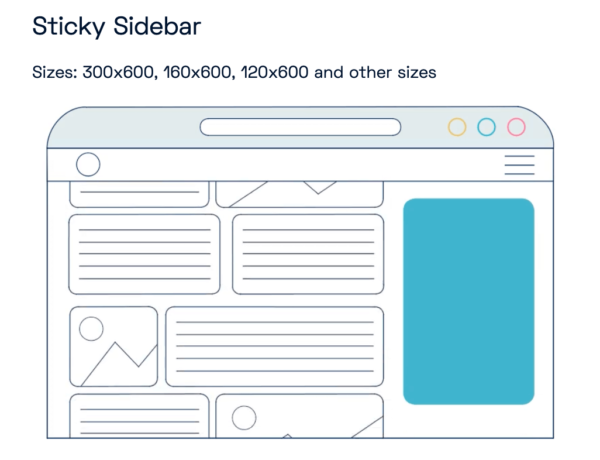
Mobile ads
Mobile ads can come in many formats, depending on their purpose, context, audience, and category. It can get quite difficult to choose which mobile ad sizes would benefit your specific needs.
Mobile advertising itself has gained a large popularity among advertisers and publishers since the mobile environment enables to reach more users and provides better targeting opportunities.
Some of the most popular mobile ad sizes and formats include 300 × 250 px medium rectangle and 336 × 280 px large rectangle.
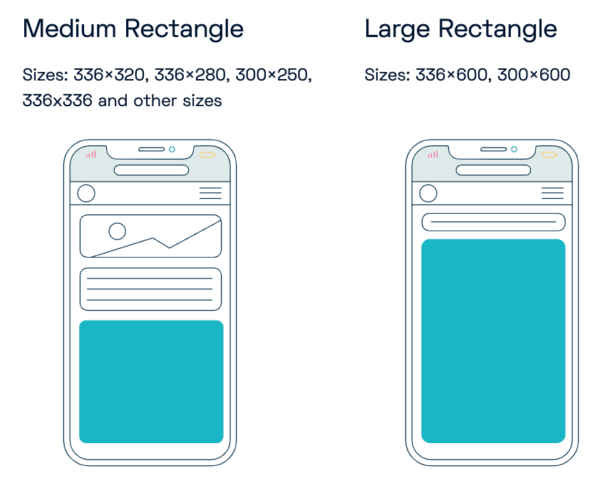
Native ads
Native ads blend into the publisher’s content matching the website’s design, look and feel. They provide a better user experience compared to other ad formats because they aren’t interruptive.
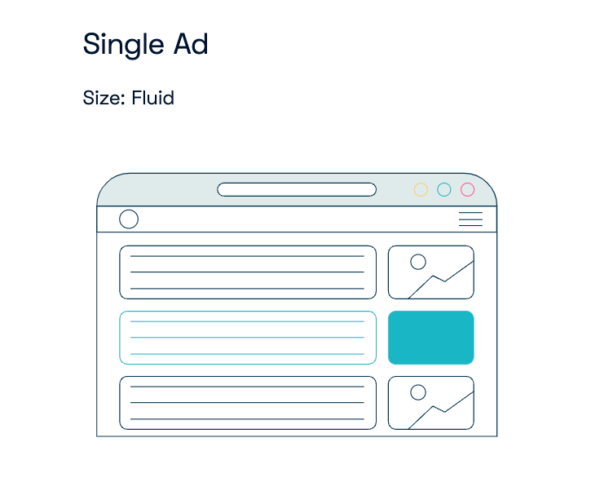
Interactive and rich media ads
Interactive and rich media ads are dynamic ads that incorporate advanced features like video, audio, or user interaction to engage viewers more effectively.
Interstitial ads
Interstitial ads are interactive, full-screen ads that are displayed when users switch to another page. They’re noticeable ad formats that either fill the screen on mobile device or float over a page on desktop.
Interstitial ads have a higher CTRs compared to standard ad formats.
Additionally, interstitial ads increase website’s ad diversity, minimize banner blindness, and improve overall ad engagement. They also have a limited frequency capping to reduce intrusiveness.
Starting from 17.10.2023., publishers will have increased control over the frequency of ads in AdSense. By default, the frequency is set to 10 minutes, but publishers can adjust this from one minute to one hour, with a lower frequency maximizing earnings and a higher frequency offering users fewer ads.
Whatsoever, Setupad doesn’t recommend setting a frequency cap to less than 10 minutes as it doesn’t provide a good user experience.
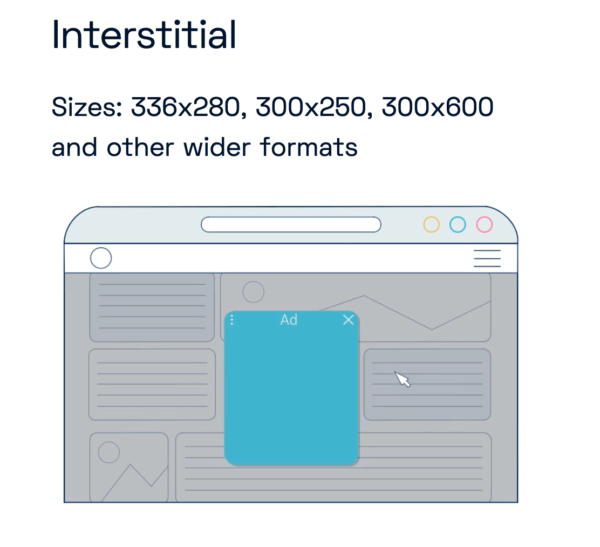
Rich media ads
The evolution of ad tech enables display ads with interactive elements (e.g., video, audio, clickable elements) known as rich media ads.
Rich media ads combine different rich media elements, such as text, images, audio, video, animations, etc. They’re more interactive and dynamic in style, and they can bring a better user experience.
Rich media ads usually deliver high CTRs and CPMs.
Video ads
Video ads use video content to promote products or services. They’re also one of the top ad formats for marketers in 2023 (more on that later) since they have a high level of visibility, high CTRs and conversion rates.
Two of the most common video ad types include instream and outstream video ads.
Instream video ads can appear before (pre-roll), during (mid-roll), or after (post-roll) video content. Usually, the viewer can skip the ad after 5 seconds, however, sometimes, the viewer has to watch the full video.
Oustream video ads are placed in non-video environments such as social media or text-based editorial content. They never prevent the viewers from seeing the content as users can scroll past them.
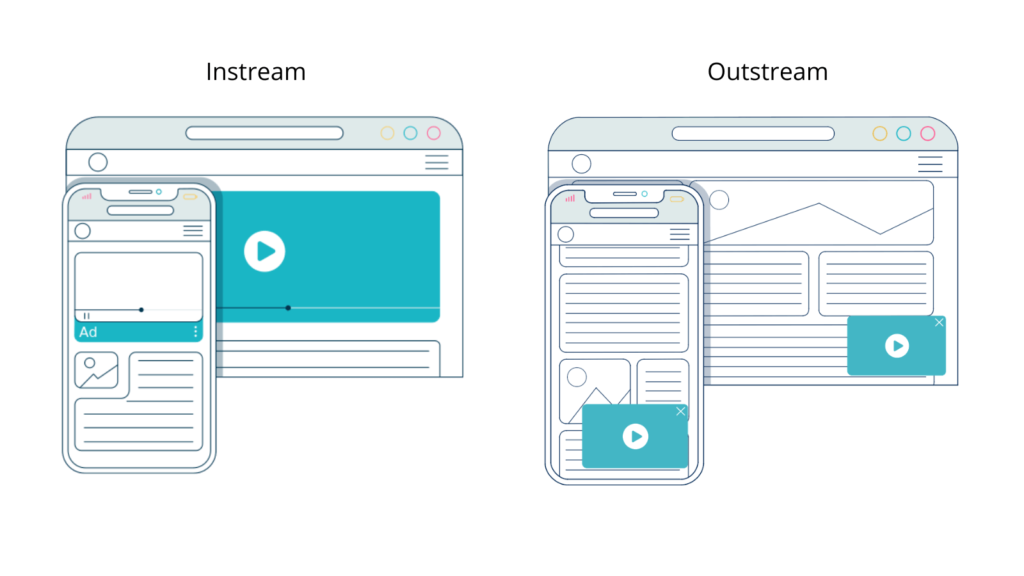
Expandable ads
Expandable ads as the name suggests expand from one size to another. That can happen automatically or when users click on the ad. They can increase user engagement, provide higher CTRs and advertisers can include more details in the ad to increase brand awareness.
Generally, expandable ads look like any other ad except the fact that they can get bigger if the user wants to know more details about the product or brand.
Floating ads
Floating ad (also known as overlay ad) slides into the main page using animation. It can be made smaller so it doesn’t cover the screen the way a pop up might.
Therefore it’s considered less intrusive, but it can grab the user’s attention and generate similar CTRs to pop up ads.
Intrusive ads
Intrusive advertising happens when ads are invasive, uwelcomed and irrelevant. Typically intrusive ads pop up unexpectedly, block the host page or play videos/audios at inappropriate times, which naturally creates a bad user experience.
Pop-up and pop-under ads
Pop-up ads are a type of an ad that appears (or “pops up”) over the content a user is viewing. These ads can appear due to various triggers, such as when a user enters a website, clicks on a specific area of a page, or is about to exit the site.
Many users find them intrusive and disruptive to their browsing experience. As a result, pop-up blockers, which prevent these ads from appearing, have become standard features in most modern web browsers.
Pop-under ads are similar to pop up ads but instead of appearing above the content they appear behind it. The viewer can decide when and whether he wants to see the ad, therefore they’re considered a little less intrusive.
The Most Common Display Ad Sizes
According to IAB, here’s a list of the most common display ads and their sizes:
| Ad unit name | Fixed size (px) |
| Billboard | 970×250 |
| Smartphone Banner | 300×50 or 320×50 |
| Leaderboard | 728×90 |
| Super leaderboard/pushdown | 970×90 |
| Portrait | 300×1050 |
| Skyscraper | 160×600 |
| Medium rectangle | 300×250 |
| Button ad | 120×60 |
| Mobile phone interstitial | 640×1136 or 750×1334 or 1080×1920 |
| Feature phone small banner | 120×20 |
| Feature phone medium banner | 168×28 |
| Feature phone large banner | 216×36 |
Additionally, data shows that in 2022 more than 40% of ad revenue in the U.S. was generated through search ads. They were followed by display ads (30.3%) and video ads (22.5%). Below, a 2023 survey shows that most marketers commonly use banner and video ads, which are followed by pop-up ads.
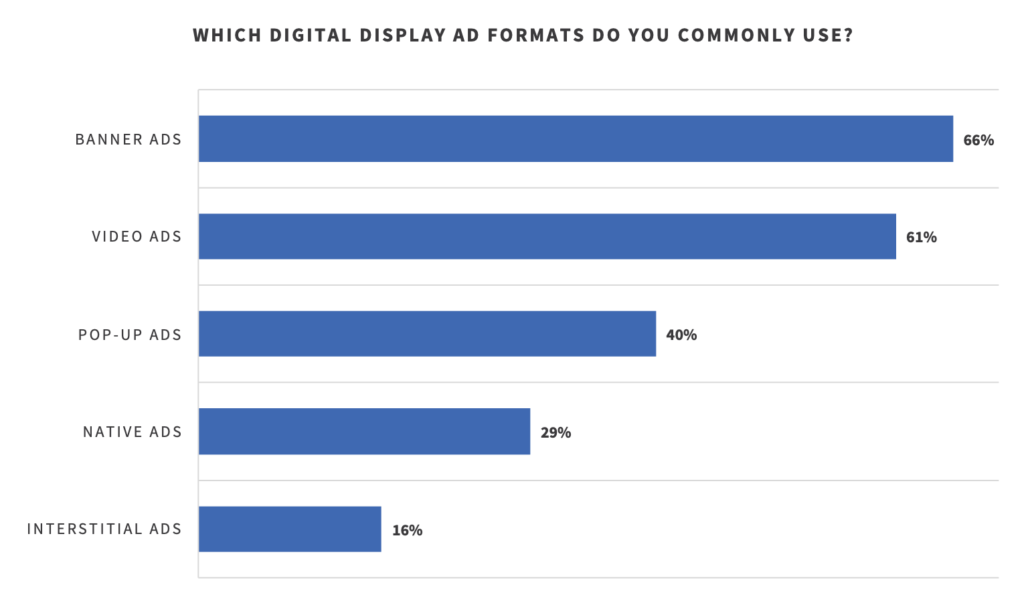
Source: Ascend2
Display Ads vs. Native Ads
Display ads are typically visual banners placed on websites, often on the sidebars, headers, or between content sections, and they clearly look like ads. They can be static images, GIFs, or videos.
Native ads, on the other hand, are designed to blend seamlessly with the platform’s content, mimicking its style and tone. They appear as part of the content feed, making them less intrusive and more engaging for users.
Setupad also provides publishers with a single native ad format. We adjust the native ads’ style to match the website’s design as closely as possible.
While display ads prioritize visibility, native ads focus on providing a more organic and integrated user experience.
| Display ads | Native ads |
| Stands out from the content on the platform on which they appear and builds brand awareness. | Visually blends in with the surrounding content in the platform on which they appear |
| Ads include text, images, and can also be interactive | Ads are static with images with text |
| Can disrupt the user’s interaction with the page | Ads don’t disrupt the user experience with the page |
| Good for raising brand awareness or promoting products/services | Focus is on information–providing answers to user’s questions, educating the audience |
Display Advertising Benefits
Here are the 9 main benefits of display advertising:
- Boosts brand awareness. Display ads significantly increase advertisers’ brand visibility across various online platforms, ensuring your brand stays top-of-mind for potential customers.
- Remarketing opportunity. Display advertising allows advertisers to retarget potential customers who’ve previously interacted with your brand, reminding them of their interest.
- Cost-effective. Compared to other marketing strategies like native ads and video campaigns, display ads often offer a more affordable option. Both CPM and CPC models provide flexibility in budgeting.
- Precision targeting. Display ads can be tailored to reach specific demographics, interests, and behaviors, ensuring an advertiser’s message reaches the most relevant audience.
- Quantifiable results. The impact of display advertising can be easily measured through metrics like click-through rates, impressions, and conversions, allowing for data-driven decision-making.
- Broad reach. Display ads have the potential to be seen by vast audiences as they appear on desktop and mobile.
- Flexible design options. Advertisers can use a mix of text, images, and even video in their display ads, allowing for creative flexibility.
- Quick launch. Unlike some campaigns that require extensive production, display ads can be created and launched relatively quickly.
- Enhances other marketing efforts. Display advertising can complement other digital marketing strategies, creating a cohesive and integrated approach to reaching potential customers.
When should you avoid display ads?
Display ads increase brand or product awareness, therefore it’s beneficial to use them in the early stages of your advertising funnel. They’re also effective when used in retargeting purposes.
Display Advertising Platforms and Networks
Display advertising platforms and networks are systems and services that facilitate the buying, selling, and management of display ads across various websites and online channels.
Google Display Network (GDN)
The Google Display Network (GDN) allows advertisers to present ads across various websites, apps, and Google-owned platforms like YouTube and Gmail. It’s designed to reach users at various stages of their purchasing journey, from initial interest to the point of purchase.
GDN employs advanced AI capabilities to enhance campaign outcomes. Key features include smart bidding, which recommends bidding strategies based on advertising goals, and the option to pay for conversions rather than clicks when using target CPA bidding.
By default, GDN uses responsive ads, where advertisers provide multiple assets, and Google’s AI determines the best combination and format for optimal performance.
Additionally, GDN’s optimized targeting uses data like landing page keywords to reach relevant audiences, ensuring ads are seen by those most likely to convert.
Google banner ad sizes:
Common Google display ad sizes include:
- 300 x 250 px
- 336 x 280 px
- 728 x 90 px, 970 x 90 px, and 468 x 60 px (leaderboard)
- 300 x 600 px, 160 x 600 px (sidebar)
- 250 x 250 px, 200 x 200 px (rectangle)
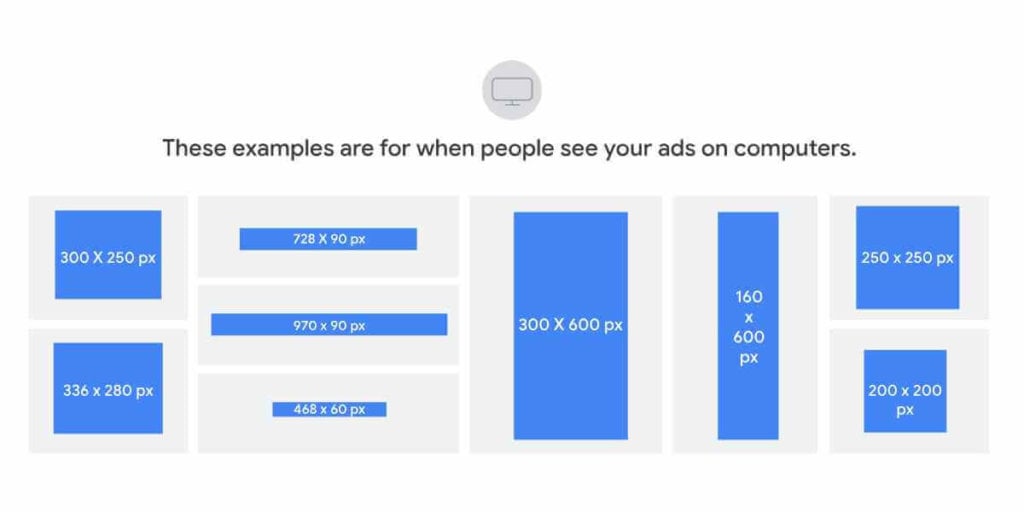
Source: Google Ads
Common Google display ad sizes for mobile include:
- 300 x 200 px
- 300 x 50 px
- 300 x 100 px
- 250 x 250 px
- 200 x 200 px
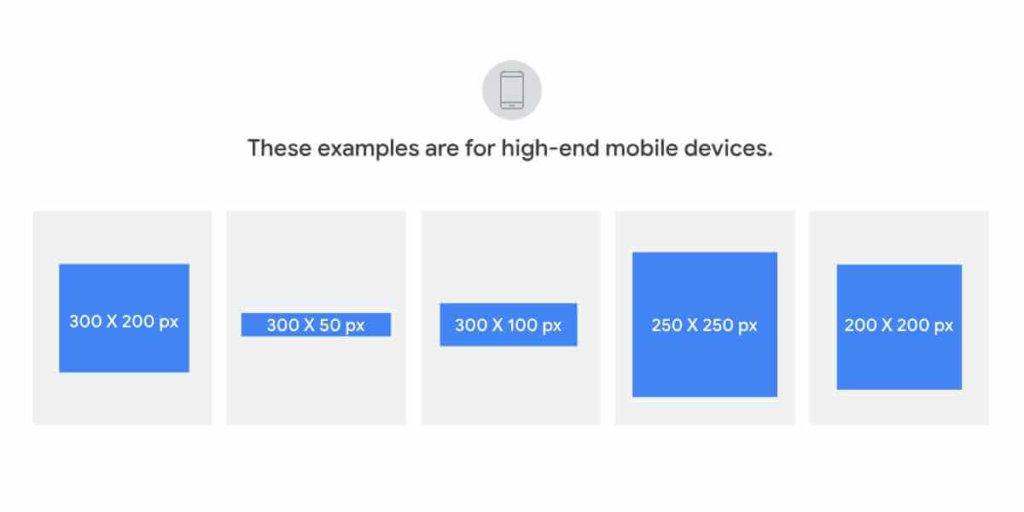
Amazon Ads
Amazon offers a comprehensive suite of display advertising solutions.
Sponsored Display is a self-managed tool that promotes brand awareness and product engagement. It uses familiar Amazon elements like star ratings and product images in its ads, ensuring ads only appear when the product is in stock and holds the featured offer.
This tool targets shoppers viewing related products or categories and offers custom-built audiences for product introductions, audience engagement, and large-scale remarketing.
On the other hand, Amazon DSP is a platform that allows advertisers to buy display, video, and audio ads both on Amazon and external platforms. It leverages Amazon’s technology and data, enabling advertisers to target based on demographics and shopping behaviors.
Amazon DSP offers in-depth insights and analytics, helping advertisers understand and optimize their campaign performance.
Amazon ad sizes:
| Amazon ad unit name | Size |
| Medium rectangle | 300 x 250 |
| Leaderboard | 728 x 90 |
| Wide skyscraper | 160 x 600 |
| Large rectangle | 300 x 600 |
| Billboard | 970 x 250 |
| Mobile leaderboard | 320 x 50 |
| Mobile detail and Search results page | 414 x 125 |
| Mobile medium rectangle | 300 x 250 |
| Mobile leaderboard (tablet | 728 x 90 |
Facebook ads
Facebook offers a variety of ad formats, each with specific size and content guidelines. Below are some examples of the main ad formats available on Facebook.
Feed ads are the primary type and appear in users’ feeds, supporting images, GIFs, and videos.
Carousel ads allow multiple images or videos in a slideshow format.
Right column ads are desktop-specific and appear on the page’s right side.
In-stream video ads show up during Facebook live feeds.
Marketplace ads appear in Facebook’s buying and selling section.
Instant articles are mobile-optimized content pieces with embedded ads.
Stories ads are temporary posts with a 24-hour lifespan.
Collection ads are tailored for e-commerce, leading users to a full-screen shopping experience.
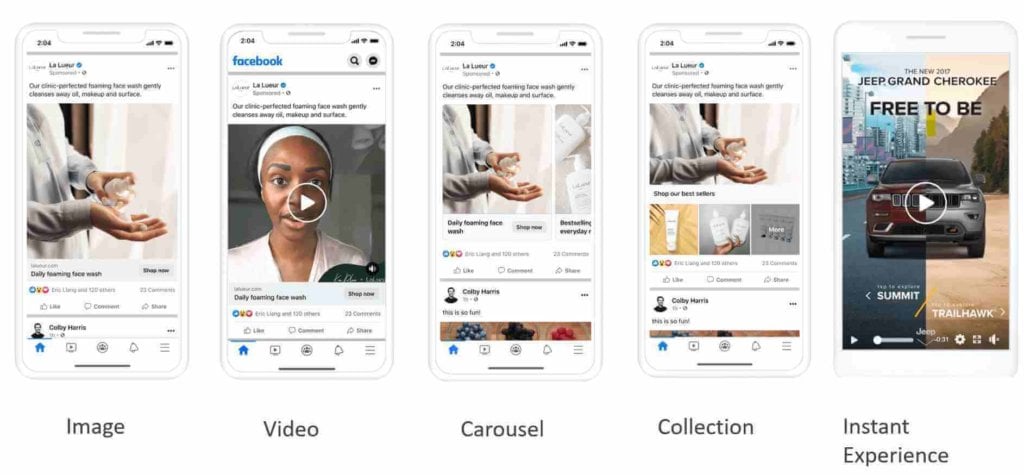
Source: Ashokcharan
Facebook ad sizes:
| Facebook ad unit name | Size |
| Carousel banner ads | 1080 x 1080 |
| Marketplace banner ads | 1200 x 628 |
| Instant articles ads | 1200 x 628 |
| Stories banner ads | 1080 x 1920 |
| Collection ads | 600 x 600 |
| Feed image ads | 1200 x 628 |
| Feed video ads | 600 x 315 |
| Right column ads | 1200 x 628 |
Instagram ads
Instagram ads appear in user feeds, stories, and the explore section, together with content from accounts and hashtags they follow, as well as suggested accounts tailored to their interests.
On the explore page, ads can be seen when users tap on content but won’t appear directly in the explore grid or topic channels.
Every Instagram ad is labeled “sponsored” and might have a CTA button.
The ad’s format determines its appearance:
- Single images can be square, landscape, or vertical;
- Videos can be square or landscape (except in stories);
- Carousels can be square or vertical in both feeds and stories.
For stories, it’s recommended to use full-screen vertical assets, but they can also support other media dimensions.
Reels ads require full-screen vertical assets, while Instagram shop ads, which can be single-image, carousel, or collection, will always appear as square images and link to your website’s product page.
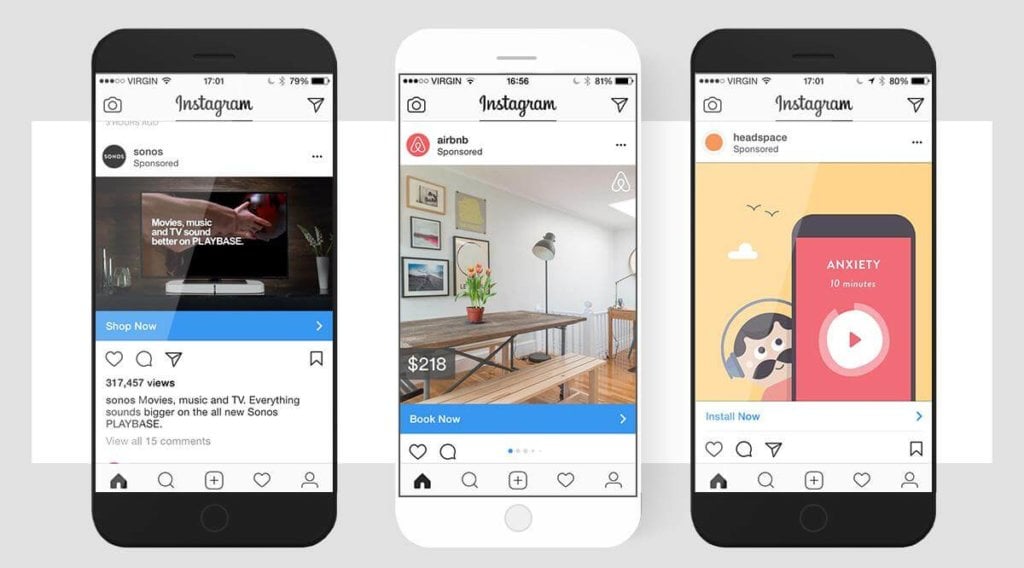
Source: Forbes
Common Instagram ad sizes:
| Instagram ad unit name | Size |
| Single Image Banner Ads | 400 x 500 |
| Video Banner Ads | 400×500 |
| Carousel Banner Ads Size | 1080 x 1080 |
| Stories Carousel Ads | 1080×1920 |
| Slideshow Banner Ads | 600 x 600 |
| Stories Image Ads | 1080 x 1920 |
| Stories Video Ads | 1080 x 1920 |
Tips for Creating Display Ads
To create engaging and visually appealing display ads advertisers should follow these 11 tips:
- Prioritize image quality. Always use high-resolution and clear images that resonate with your brand and message.
- Craft a clear message. Be concise and use uplifting, positive language. Avoid jargon and overly complex terms.
- Highlight your product/service. Ensure your product or service is the central focus of the image, making it instantly recognizable to viewers.
- Promote your USP (unique selling point) and CTA. Clearly communicate what sets your product apart and guide viewers with a compelling Call to Action, urging them to take the next step.
- Embrace minimalism. A clutter-free design is key. Avoid overwhelming viewers with too many elements or information.
- Optimize for mobile. With many users on mobile devices, ensure your ads look great and function well on smaller screens.
- Adopt responsive design. Your ad’s layout and elements should adapt seamlessly depending on where and how it’s being displayed.
- Test and refine. Regularly perform A/B testing on different ad variations to determine which designs and messages resonate most with your audience.
- Leverage social proof. Incorporate elements like customer reviews, awards, or celebrity endorsements to build trust and credibility.
- Stay consistent with branding. Ensure your ads align with your brand’s colors, fonts, and overall aesthetic to maintain brand recognition and trust.
- Use dynamic content. Consider using dynamic content that can change based on user behavior, location, or other factors to make the ad more relevant to individual viewers.
Targeting and Personalization
Targeting is the compass of display advertising. It ensures that ads reach the right audience, maximizing engagement and conversion rates. This precision not only boosts ad effectiveness but also enhances user experience as viewers encounter more relevant and tailored ad content.
By segmenting audiences based on demographics, interests, behaviors, or past interactions with a brand (retargeting), publishers can offer advertisers a higher return on investment.
Demographic targeting: Age, gender, and more
Demographic targeting is the cornerstone of any advertising strategy. By segmenting audiences based on fundamental characteristics like age, gender, location, education, or income, advertisers can tailor their messages to resonate more deeply.
For publishers, understanding the demographics of their audience allows them to attract advertisers looking for specific market segments.
It’s not just about reaching people–it’s about reaching the right people with messages that matter to them.
Behavioral targeting: Based on user actions
Every click, search, and online purchase tells a story. Behavioral targeting interprets this story, allowing advertisers to tailor ads based on users’ online actions.
Whether it’s the sites they frequent, the products they’ve browsed, or the content they’ve engaged with, these behaviors provide priceless insights. For publishers, this means delivering ads that are more relevant and likely to engage, enhancing user experience and increasing ad effectiveness.
Contextual targeting: Aligning with content themes
Context is the king in the realm of advertising. Contextual targeting ensures that ads align with the content themes of the page they’re displayed on.
For example, an ad for hiking boots would fit on a blog about mountain trails.
Publishers benefit by offering advertisers a platform where their ads feel organic and relevant, leading to higher engagement rates and a more cohesive user experience.
Retargeting: Capturing lost opportunities
Only some browsing sessions lead to an immediate purchase or conversion. Retargeting is the art of re-engaging those who’ve shown interest but haven’t taken the final step. By displaying ads to users based on their past interactions with a brand or website, retargeting aims to reignite interest and drive conversions.
This means that publishers can host ads with a higher likelihood of engagement, as they’re targeted toward users already familiar with the brand or product.
How to understand your audience for better personalization?
Personalization is the key to standing out. But to personalize effectively, understanding your audience is essential.
Publishers should delve into analytics, survey tools, and user feedback to gain insights into their audience’s preferences, behaviors, and pain points. By creating audience personas and mapping out their journey, publishers can offer advertisers a platform where ads are not just seen but also felt.
The deeper the understanding, the more tailored and impactful the advertising experience becomes.
Measuring Display Ad Performance: Key Performance Indicators (KPIs)
In display advertising, success isn’t just about launching campaigns, it’s about measuring their impact. Key performance indicators (KPIs) guide advertisers and publishers in understanding the effectiveness of their ads.
By analyzing these metrics, one can refine strategies, optimize campaigns, and ensure that every ad dollar is well-spent.
A 2023 study shows that marketers prioritize specific metrics to assess the effectiveness of their digital display advertising campaigns. A majority, with 54%, rely on engagement indicators (e.g., likes, shares, and comments) to gauge how audiences interact with their ads.
Similarly, 53% consider the CTR as a testament to the ad’s ability to capture attention and prompt action. Additionally, 47% of marketers emphasize conversion rates, which track the percentage of users completing a desired action post-click, such as making a purchase.
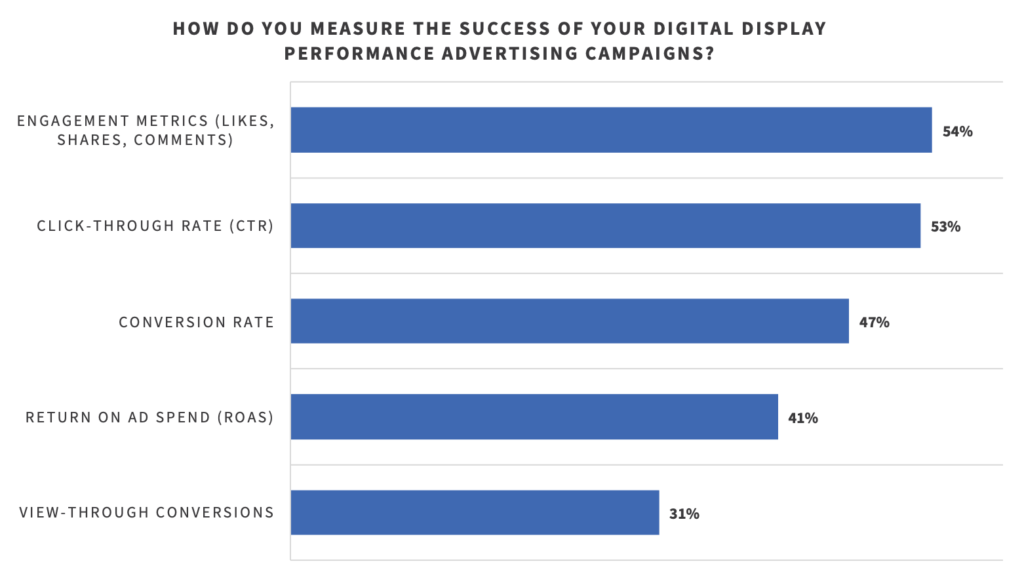
Source: Ascend2
Click-Through Rate (CTR)
CTR measures the percentage of viewers who click on an ad after seeing it. A high CTR indicates that the ad’s design, message, and placement resonate with the audience.
CTR optimization assures publishers that the ads are not just seen but also acted upon.
Conversion Rate
Beyond clicks, the accurate measure of an ad’s effectiveness lies in conversions. Whether it’s making a purchase, signing up for a newsletter, or any other desired action, the conversion rate gauges the percentage of users who take that step after clicking on an ad.
It’s the bridge between interest and action, and for publishers, it’s a metric that showcases the tangible results of advertising efforts.
Reach (Impressions)
Reach, often represented by the number of impressions, quantifies how often an ad is displayed and potentially seen by users. It’s a measure of visibility and scale.
Ensuring a broad reach shows that content and ad spaces attract a wide audience, amplifying the potential impact of every ad displayed.
Cost
Every ad comes with a price tag. Whether it’s cost per click (CPC), cost per thousand impressions (CPM), or any other model, understanding the cost associated with display advertising is crucial.
It’s about balancing revenue goals with advertiser satisfaction, ensuring that ad spaces offer competitive rates while delivering value.
Return on investment (ROI)
ROI is the ultimate metric of profitability. It calculates the net profit of an advertising campaign relative to its cost.
A positive ROI indicates that the gains from the ad exceed its expenses.
If publishers showcase a strong ROI, it means that their platform not only delivers visibility but also tangible financial results for advertisers.
Brand awareness and engagement
Beyond numbers, there’s an intangible impact of ads. Brand awareness and engagement metrics delve into how ads influence users’ perceptions and interactions with a brand.
This can be measured through surveys, social media mentions, or direct interactions. Fostering increased brand engagement means the publisher’s platform is a space where brands can truly connect with audiences, building lasting relationships.
How to Optimize Display Ad Campaigns?
Optimizing display ad campaigns ensures that every campaign element adapts to produce the desired outcome. Whether it’s adjusting visuals, budgets or understanding audience behavior, optimization ensures that campaigns not only reach their target audience but also resonate with them.
A/B testing
A/B testing is the scientific method of the advertising world. By creating two versions of an ad (A and B) and testing them simultaneously, advertisers can determine which one performs better in real-time.
This can involve changing a headline, using a different image, or tweaking a CTAs.
For publishers, A/B testing offers insights into what their audience prefers, allowing them to provide more valuable feedback to advertisers and optimize ad placements.
Budget and bidding strategy adjustment
Adjusting budget allocations and bidding strategies can significantly influence an ad’s visibility and performance.
By analyzing which placements or times of day yield the best results, advertisers can reallocate budgets to maximize impact. Similarly, tweaking bidding strategies in real-time auctions can ensure that ads appear in the most coveted spots without overspending.
Analyzing and adapting to audience behavior
Audiences are dynamic, and their preferences evolve. By diving deep into analytics and understanding how users interact with ads, advertisers can adapt their strategies.
This might mean targeting a different demographic, changing ad placements, or even redefining campaign goals.
Understanding audience behavior is crucial for curating content and ad experiences that captivate and engage.
Challenges in Display Advertising
Ad blockers
The rise of ad blockers is a testament to users’ desire for an uninterrupted browsing experience. These tools prevent ads from being displayed, posing a direct challenge to publishers’ monetization efforts.
Overcoming this requires a mix of technical solutions, like anti-ad blockers, and creating non-intrusive ads that users choose not to block.
Ad fraud
Ad fraud generally involves falsifying the clicks or impressions an ad receives, thus generating extra revenue.
A significant majority of marketing professionals, 81% to be precise, show some level of concern about potential financial losses due to digital ad fraud or bots, which can negatively affect their ROI. From which, 23% are highly alarmed about such threats, indicating a deep-seated worry.
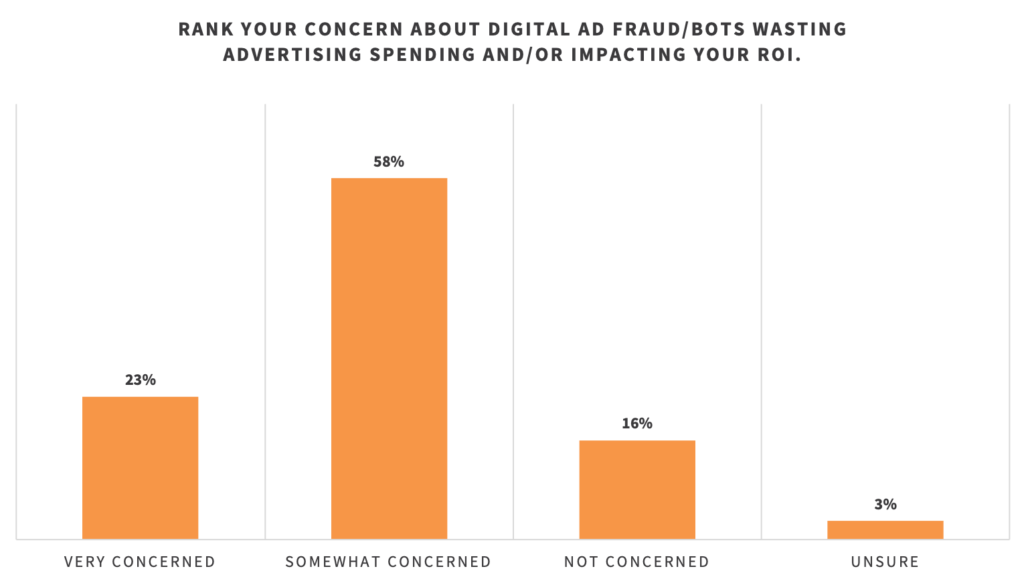
Source: Ascend2
Banner blindness
Over time, regular online users develop a subconscious habit of ignoring banner ads, a phenomenon called ”banner blindness”.
Combatting this requires advertisers to be more creative and strategic in their ad placements, ensuring they capture attention without being overly aggressive. Publishers can help by offering diverse ad formats and placements that blend seamlessly with content.
Creativity vs. effectiveness
Striking the balance between a visually stunning ad and one that drives results is a real challenge.
While creativity captures attention, the ad’s message and CTA drive conversions. Advertisers and publishers must collaborate to ensure that ads are not just eye-catching but also aligned with campaign objectives, ensuring that beauty and purpose go hand in hand
The Future of Display Advertising
The rise of augmented reality (AR) and virtual reality (VR) ads
AR (augmented reality) and VR (virtual reality) technologies allow users to immerse themselves in interactive ad experiences. While these technologies are relatively new in the advertising world, their market is expanding swiftly.
Data shows that by 2025, the global revenue from AR advertising is expected to reach $6.68 billion. This is a significant surge when compared to 2020, where the AR ad revenue was at $1.36 billion.
Note: AR uses real-world settings and can be accessed through mobile, while VR is completely virtual and requires a headset device. In other words, AR can enhance both the real and virtual world, while VR only enhances the fictional reality.
VR ads can be used in the tourism industry to replicate travel experiences, such as visiting the Utah Beach museum or The Empire State Building, e.g.; Thomas Cook, a travel agency based in the UK, launched its “Try Before You Fly” campaign, which enabled users to experience a vacation in specific locations virtually.
Ikea also launched a VR-based app that allowed users to place virtual 3D models of their furniture in their own homes.
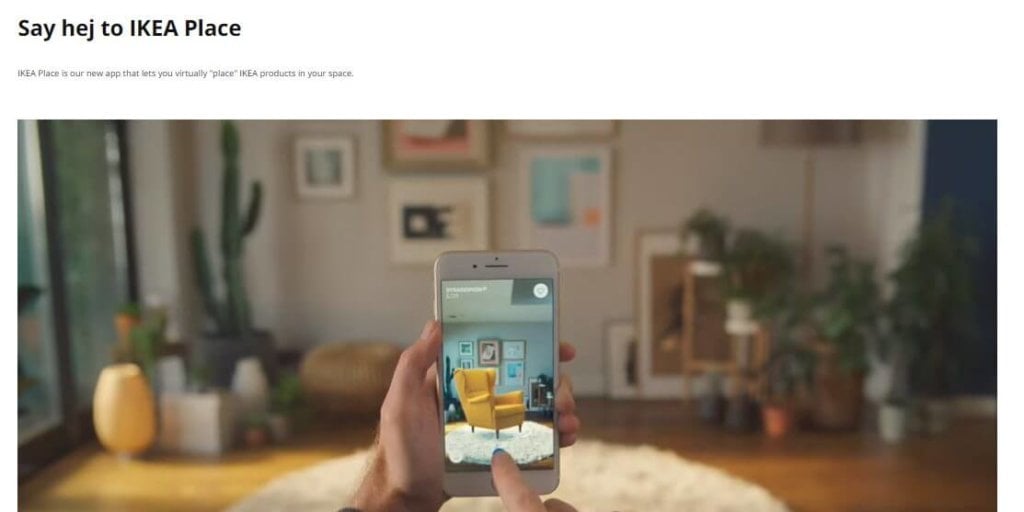
Source: InfluencerMarketingHub
For publishers, using AR or VR technologies means hosting ads that are not just viewed but experienced, offering unparalleled engagement opportunities.
Artificial intelligence in ad creation and targeting
Artificial Intelligence (AI) is revolutionizing display advertising. From creating ads that adapt in real-time based on user behavior to predictive targeting that anticipates user needs, AI is making advertising more intuitive and effective.
AI-driven ads mean higher relevance and engagement, as ads self-optimize to resonate with individual users, ensuring that content and advertising are in perfect harmony.
For example, in May 2023 Meta announced their AI Sandbox for advertisers to facilitate ad campaign creation. This feature includes tools that help with text creation, background generation and image outcropping.
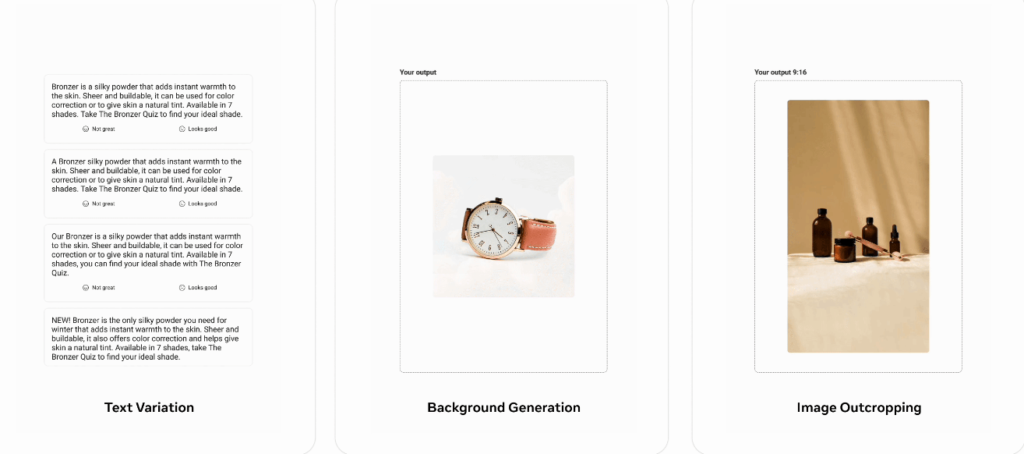
Source: Meta
The ongoing shift to mobile and responsive designs
Mobile advertising has surged in prominence due to the widespread use of smartphones and tablets. Google has announced the completion of its transition to mobile-first indexing, meaning it now prioritizes mobile versions of websites when crawling and indexing content.
This shift emphasizes Google’s intensified focus on mobile users, reflecting the global trend of increased mobile web usage. As a result, mobile advertising will be even more crucial as the user experience on mobile devices becomes the primary consideration for web content.
Additionally, Google will reduce the crawling of desktop pages, emphasizing the importance of optimizing sites for mobile viewing.
Implementing responsive designs guarantees that ads seamlessly adapt and deliver optimal performance on any screen size, from expansive desktop monitors to compact mobile interfaces.
How Can Setupad Help?
Setupad is an analytics-driven monetization platform that enables publishers to unlock their maximum ad revenue potential. As a Google Certified Publishing Partner (GCPP) and an official Prebid member, Setupad offers one of the most advanced ad stacks available.
- This includes our own ad server, 11 server-to-server integrations, 31 premium demand partners, and impression-level optimization between programmatic and direct sales.
By entrusting us with the broadest ad placement dimensions, you open doors to a wide range of unique, custom-made ad formats tailored to preserve the user experience while delivering maximum value to advertisers. Not only does this ensure your content remains engaging and relevant, but it also paves the way for enhanced revenue streams.
Dive into the world of display advertising with Setupad and watch your ad revenue grow!
Conclusion
With digital advertising, publishers stand at a crossroads between user experience and revenue generation. Display advertising, with its visual appeal and adaptability, offers a powerful opportunity for content monetization.
Beyond mere visuals, display ads offer a strategic avenue for capturing the user’s attention and driving engagement.
However, it’s beneficial to leverage platforms like Setupad, which optimize ad placements and introduce custom ad dimensions, ensuring publishers tap into every revenue opportunity.
There are many benefits of display advertising–from broadening brand visibility to facilitating precise audience targeting. Whatsoever, in this journey, informed choices and strategic partnerships will define real success.
Frequently Asked Questions
What is the average cost of display advertising?
The average cost of display advertising varies based on factors like platform, targeting, and ad quality. Typically, costs can range from a few cents to several dollars per click (CPC) or per thousand impressions (CPM).
How do I ensure my target audience sees my display ads?
To ensure your target audience sees your display ads, use precise targeting options available on ad platforms, such as demographic, behavioral, and contextual targeting. Then, regularly review and refine your targeting criteria based on campaign performance.
What are the best tools for designing display ads?
Popular tools for designing display ads include Adobe Creative Cloud (especially Photoshop and Illustrator), Canva, and other tools like Canva and Bannersnack. The choice depends on your design expertise and specific needs. If you plan to use Photoshop, remember to periodically clear the Photoshop cache so your device
does not slow down over time.
How do I measure the ROI of my display advertising campaign?
To measure the ROI of your display ad campaign, track metrics like CTR, conversion rate, and overall sales generated from the ads. Subtract the ad spend from the revenue generated, divide by the ad spend, and multiply by 100 to get the ROI percentage.
Is display advertising still effective with the rise of ad blockers?
Yes, display advertising remains effective despite the rise of ad blockers. While ad blockers can reduce visibility, marketers can counteract this by focusing on high-quality, relevant content and considering native ads or sponsored content, which is less likely to be blocked.


